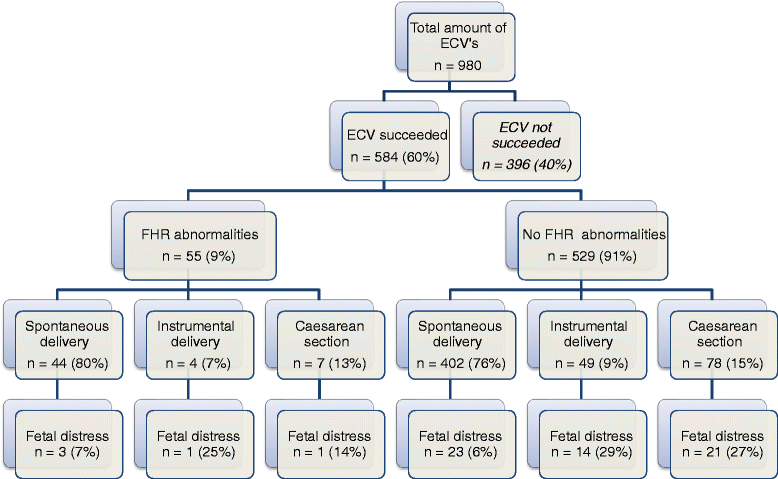Fetal heart rate abnormalities during and after external cephalic version: Which fetuses are at risk and how are they delivered?
- PMID: 29041923
- PMCID: PMC5646157
- DOI: 10.1186/s12884-017-1547-6
Fetal heart rate abnormalities during and after external cephalic version: Which fetuses are at risk and how are they delivered?
Abstract
Background: Fetal heart rate abnormalities (FHR) during and after external cephalic version (ECV) are relatively frequent. They may raise concern about fetal wellbeing. Only occasionally they may lead to an emergency cesarean section.
Methods: Prospective cohort study in 980 women (> 34 weeks gestation) with a singleton fetus in breech presentation. During and after external cephalic version (ECV) FHR abnormalities were recorded. Obstetric variables and delivery outcome were evaluated. Primary outcome was to identify which fetuses are at risk for FHR abnormalities. Secondary outcome was to identify a possible relationship between FHR abnormalities during and after ECV and mode of delivery and fetal distress during subsequent labor.
Results: The overall success rate of ECV was 60% and in 9% of the attempts there was an abnormal FHR pattern. In two cases FHR abnormalities after ECV led to an emergency CS. Estimated fetal weight per 100 g (OR 0.90, CI: 0.87-0.94) and longer duration of the ECV-procedure (OR 1.13, CI: 1.05-1.21) were factors significantly associated with the occurrence of FHR abnormalities. FHR abnormalities were not associated with the mode of delivery or the occurrence of fetal distress during subsequent labor.
Conclusions: FHR abnormalities during and after ECV are more frequent with lower estimated fetal weight and longer duration of the procedure. FHR abnormalities during and after ECV have no consequences for subsequent mode of delivery. They do not predict whether fetal distress will occur during labor.
Trial registration: The Eindhoven Breech Intervention Study, NCT00516555 . Date of registration: August 13, 2007.
Keywords: Breech presentation; External cephalic version; Fetal distress; Fetal heart rate; Mode of delivery; Pregnancy.
Conflict of interest statement
Ethics approval and consent to participate
The medical ethics review committee of the Catharina Hospital Eindhoven approved this research on March 15, 2007. Reference number: M06/1697. Written informed consent was obtained.
Consent for publication
Participants gave their consent for publication.
Of all participants who were included in the study written informed consent was taken.
Competing interests
The authors declare that they have no competing interests.
Publisher’s Note
Springer Nature remains neutral with regard to jurisdictional claims in published maps and institutional affiliations.
Figures
Similar articles
-
[Breech Presentation: CNGOF Guidelines for Clinical Practice - External Cephalic Version and other Interventions to turn Breech Babies to Cephalic Presentation].Gynecol Obstet Fertil Senol. 2020 Jan;48(1):81-94. doi: 10.1016/j.gofs.2019.10.024. Epub 2019 Oct 31. Gynecol Obstet Fertil Senol. 2020. PMID: 31678503 Review. French.
-
Efficacy of a second external cephalic version (ECV) after a successful first external cephalic version with subsequent spontaneous reinversion to breech presentation: a retrospective cohort study.Arch Gynecol Obstet. 2021 Apr;303(4):911-916. doi: 10.1007/s00404-020-05819-5. Epub 2020 Oct 6. Arch Gynecol Obstet. 2021. PMID: 33025088
-
The effect of transient fetal bradycardia and other heart rate changes during and after external cephalic version on perinatal outcomes.Eur J Obstet Gynecol Reprod Biol. 2020 Feb;245:39-44. doi: 10.1016/j.ejogrb.2019.11.025. Epub 2019 Nov 21. Eur J Obstet Gynecol Reprod Biol. 2020. PMID: 31838399
-
Mode of childbirth and neonatal outcome after external cephalic version: A prospective cohort study.Midwifery. 2016 Aug;39:44-8. doi: 10.1016/j.midw.2016.02.014. Epub 2016 Mar 3. Midwifery. 2016. PMID: 27321719
-
Obstetric and Anesthetic Approaches to External Cephalic Version.Anesthesiol Clin. 2017 Mar;35(1):81-94. doi: 10.1016/j.anclin.2016.09.008. Anesthesiol Clin. 2017. PMID: 28131122 Review.
Cited by
-
Evaluation of Critical Factors of Postoperative Arrhythmia and Preventive Measures of Deep Venous Thrombosis.J Oncol. 2021 Nov 24;2021:6103092. doi: 10.1155/2021/6103092. eCollection 2021. J Oncol. 2021. Retraction in: J Oncol. 2023 Aug 2;2023:9854354. doi: 10.1155/2023/9854354. PMID: 34868315 Free PMC article. Retracted.
-
Reviving external cephalic version: a review of its efficacy, safety, and technical aspects.Obstet Gynecol Sci. 2019 Nov;62(6):371-381. doi: 10.5468/ogs.2019.62.6.371. Epub 2019 Oct 8. Obstet Gynecol Sci. 2019. PMID: 31777732 Free PMC article. Review.
-
The Effect of External Cephalic Version on Fetal Circulation: A Prospective Cohort Study.Children (Basel). 2023 Feb 10;10(2):354. doi: 10.3390/children10020354. Children (Basel). 2023. PMID: 36832483 Free PMC article.
References
Publication types
MeSH terms
Associated data
LinkOut - more resources
Full Text Sources
Other Literature Sources
Medical


